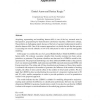697 search results - page 75 / 140 » Symbols are not uniquely human |
162
Voted
CANDC
2009
ACM
14 years 10 months ago
2009
ACM
This poster puts forward the concept of a physical creative footprint which is specific and necessary to individuals' and groups' creativity in the workplace. The impact...
133
Voted
FTCS
1993
15 years 1 months ago
1993
Although the present work does in fact employ training data, it does so in the interest of calibrating the results Six hundred faults were induced by injection into five live obtai...
94
Voted
RAS
2008
15 years 1 days ago
2008
Acquiring, representing and modeling human skills is one of the key research areas in teleoperation, programming-by-demonstration and human-machine collaborative settings. The pro...
129
click to vote
HUC
2011
Springer
14 years 6 days ago
2011
Springer
GPS-equipped taxis can be viewed as pervasive sensors and the large-scale digital traces produced allow us to reveal many hidden “facts” about the city dynamics and human beha...
102
Voted
GROUP
2003
ACM
15 years 5 months ago
2003
ACM
In this paper we describe a current group configuration that is used to support people with cognitive disabilities (hereinafter referred to as “clients”) in the workplace. A c...


